Abstract
Colistin heteroresistance has been identified in several bacterial species, including Escherichia coli and Klebsiella pneumoniae, and may underlie antibiotic therapy failures since it most often goes undetected by conventional antimicrobial susceptibility tests. This study utilizes population analysis profiling (PAP) and time–kill assay for the detection of heteroresistance in K. pneumoniae and for evaluating the association between in vitro regrowth and heteroresistance. The mechanisms of colistin resistance and the ability of combination therapies to suppress resistance selection were also analysed. In total, 3 (18%) of the 16 colistin-susceptible strains (MIC ≤ 2 mg/L) were confirmed to be heteroresistant to colistin by PAP assay. In contrast to the colistin-susceptible control strains, all three heteroresistant strains showed regrowth when exposed to colistin after 24 h following a rapid bactericidal action. Colistin resistance in all the resistant subpopulations was due to the disruption of the mgrB gene by various insertion elements such as ISKpn14 of the IS1 family and IS903B of the IS5 family. Colistin combined with carbapenems (imipenem, meropenem), aminoglycosides (amikacin, gentamicin) or tigecycline was found to elicit in vitro synergistic effects against these colistin heteroresistant strains. Our experimental results showcase the potential of combination therapies for treatment of K. pneumoniae infections associated with colistin heteroresistance.
1. Introduction
K. pneumoniae is one of the most clinically significant Gram-negative bacteria that causes both community- and hospital-acquired infections, and it is associated with high mortality rates owing to its globally increasing resistance rates to multiple currently available antibiotics including carbapenems [1]. Currently, colistin treatment is considered as a salvage therapy for patients infected with multi-drug-resistant (MDR) Gram-negative bacteria such as K. pneumoniae [2]. MDR is defined as acquired non-susceptibility to at least one agent in three or more antimicrobial categories [3]. Consequently, due to its increasing usage in human medicine, reports of colistin resistance in K. pneumoniae have been on the rise [4,5,6,7,8,9]. Colistin, a cation polypeptide, was adopted as one of the last-line drugs for treating infections caused by MDR and XDR Gram-negative organisms. It works by binding to the negatively charged lipid A due to electrostatic interactions between the positively charged α,γ- diaminobutyric acid residues of colistin and the anionic phosphate groups of lipid A. Consequently, Mg2+ and Ca2+ are displaced from the phosphate groups of membrane lipids. This impairs the lipopolysaccharides, causing the outer membrane to become more permeable, which causes leakage of cytoplasmic content and eventually results in cell death [5,10]. Unfortunately, reports of colistin resistance mainly due to chromosomally encoded mechanisms have been on the rise. Resistance is mainly associated with mutations in the two-component regulatory systems, PmrAB and PhoPQ, or MgrB, which negatively regulates PhoPQ, and CrrAB, which regulates PmrAB. These mutations lead to the enzymatic substitutions of phosphate groups of lipid A with the cationic side chains, 4-amino-4-deoxy-L-arabinose and phosphoethanolamine, which lowers the net negative charge of the LPS and thus its affinity for binding to colistin [5,11]. Mobilizable insertion elements (ISs), particularly ISL3 (ISKpn25), IS5 (ISKpn26), ISKpn14, and IS903B, were commonly identified to have been integrated into the mgrB gene in recent studies [12]. This mechanism of mgrB gene disruption by IS elements results in the development of colistin resistance in K. pneumoniae [13].
Several studies have highlighted that conventional MIC determination methods only detect homogenous resistant populations but fail to detect colistin heteroresistant strains (CH), which may lead to treatment failure [7]. Antibiotic heteroresistance is a phenotype in which a bacterial isolate contains resistant subpopulations of cells within an overall susceptible isolate which belongs to the same isogenic clone [14,15]. Heteroresistance to various classes of antimicrobials has been detected both in Gram-positive and in Gram-negative bacteria, and, most notably, against colistin in K. pneumoniae and in Acinetobacter baumannii [16,17]. During conventional antimicrobial susceptibility testing (AST), the presence of sporadic colonies growing within the inhibition area of a gradient strip or disc diffusion assay or the skipped wells observed in colistin broth microdilution assays of Klebsiella spp. and Enterobacter spp. can be used as a possible indicator of the presence of heteroresistance [15,18,19], although population analysis profiling (PAP) remains the reference method for the confirmation of heteroresistance [15]. Also, there is an increase in evidence suggesting the efficacy of drug combinations targeting colistin heteroresistance and multidrug heteroresistance for the treatment of infections caused by pandrug-resistant Gram-negative bacteria [20,21,22,23].
In our study, we used PAP to detect colistin heteroresistance, and we further analysed the underlying molecular mechanisms associated with heteroresistance among the identified CH K. pneumoniae strains. Also, we evaluated the potential of several drug combinations in preventing the regrowth of resistant subpopulations in CH strains via time–kill curve assays.
2. Materials and Methods
2.1. Bacterial Strain Collection and MIC Determination
We selected 55 colistin-susceptible (CS), unduplicated clinical isolates of MDR K. pneumoniae strains belonging to different sequence types from a collection of strains originating from specimens of intensive care unit patients in different countries in Europe as part of a multi-centre clinical trial from 1 December 2013 to 31 May 2017 (https://cordis.europa.eu/project/id/282512, accessed on 7 June 2023 NCT02208154; EU-FP7 RGNOSIS). MALDI-TOF (Bruker, Germany) was used to confirm the identification of the isolates to species level. Colistin MICs were determined by broth microdilution using Micronaut colistin-MIC strips (Merlin Diagnostika, Berlin, Germany) according to EUCAST 2023 (v 13.0) (Table 1). CS strains E. coli ATCC-25922, P. aeruginosa ATCC-27853, and colistin-resistant (CR) strains E. coli NCTC-13846 (mcr-1 positive), K. pneumoniae 8400, were included as quality control strains for colistin MIC determination. Determination of MICs to other antimicrobial agents was performed via a quantitative gradient diffusion method (E-test, bioMérieux, Marcy-l’Étoile, France) (for gentamicin, imipenem, meropenem and tigecycline) and by broth microdilution (for amikacin) according to EUCAST 2023 (v 13.0) guidelines and clinical breakpoints (Table 1). Escherichia coli ATCC 25922 was used as quality control for amikacin, gentamicin, meropenem, imipenem and tigecycline MIC determination.

Table 1.
MIC of CH strains against colistin (COL), gentamicin (GEN), amikacin (AMI), imipenem (IMI), meropenem (MER), tigecycline (TIG) and resistance genes (aminoglycoside and carbapenem) identified in them.
2.2. Detection of Colistin Heteroresistant Strains by Population Analysis Profiling (PAP) Assays
K. pneumoniae strains which displayed skipped wells in colistin broth microdilution assays as well as those found to be colistin-susceptible but with colistin MIC values close to the clinical resistance breakpoint (i.e., MIC of 2 mg/L) were considered as screening phenotypes indicating possible colistin heteroresistance, and were selected to undergo PAP assay. The strains were incubated overnight in Mueller Hinton Broth (MHB) (BD BBLTM, NJ, USA); then, 100 µL of 0.5 McF bacterial suspension was plated on a series of Mueller Hinton Agar (MHA) (BD BBLTM, NJ, USA) plates containing colistin in increasing concentrations (0.5 mg/L; 1 mg/L; 2 mg/L; 4 mg/L, 8 mg/L; 16 mg/L) [24]. The number of colonies were counted after 24 h of aerobic incubation of the plates at 37 °C, and a graph of the log10 CFU/mL was plotted against the increasing colistin concentrations. CH was defined as the detection of a resistant subpopulation which grew at a colistin concentration of ≥8× the MIC of the main susceptible population and at a frequency ≥1 × 10−7 [14]. K. pneumoniae ATCC 13883 (colistin-heteroresistant; MIC 1 mg/L) [25], E. coli ATCC-25922 (colistin-susceptible; MIC 0.25 mg/L), K. pneumoniae AN0222 (colistin-susceptible; MIC 0.25 mg/L) and K. pneumoniae 8400 (colistin-resistant; MIC 64 mg/L) were included as quality control strains in the PAP assays.
2.3. Time–Kill Assays
The time–kill kinetics of colistin alone or in association with several other drugs against the three confirmed CH K. pneumoniae strains (AN1505, IT0035, ITR0244) were assessed by adding colistin and other antibiotics to a broth bacterial culture in the logarithmic phase of growth containing approximately 106 CFU/mL. The concentrations of all utilized antibiotics were adjusted to approach the peak serum concentration in patients receiving standard doses (colistin, 2 mg/L; tigecycline, 1 mg/L; amikacin, 64 mg/L; gentamicin, 16 mg/L; meropenem, 23 mg/L; imipenem, 26 mg/L) [20,26,27,28]. The cultures were incubated at 37 °C while being shaken at 220 rpm, and samples were collected after 0, 0.5, 2, 4, 8, 16 and 24 h of adding colistin. In total, 50 μL of the cultures and/or their serial dilutions was then spirally plated onto MHA plates, and the colonies were quantified after 24 h of aerobic incubation at 37 °C. Time–kill curves were then constructed by plotting the log10 CFU/mL against the various timepoints [23]. CH K. pneumoniae ATCC 13883 and CS K. pneumoniae AN0222 strain served as quality control strains.
2.4. Whole-Genome Sequencing and Analysis
Parental CH K. pneumoniae strains (AN1505, IT0035, ITR0244) and their resistant subpopulation colonies (AN1505-R1, AN1505-R2, IT0035-R1, IT0035-R2, ITR0244-R1, ITR0244-R2) were grown in MHB (Sigma Aldrich, Darmstadt, Germany). According to manufacturer instructions, genomic DNA was isolated using MasterPure Complete DNA and RNA Purification Kit (Epicentre, Madison, WI, USA). The isolated DNA was purified and concentrated with the Genomic DNA Clean & Concentrator-10 kit (Zymo, Irvine, CA, USA). Sequence libraries were then prepared using NexteraXT sample preparation kit, sequenced 2 × 250 bp, MiSeq (Illumina, San Diego, CA, USA). The quality of the raw sequences was assessed using FastQC, and primary analysis was performed using BacPipe v.1.2.6. CLC Genomics Workbench v. 9.5.1 (Qiagen, Hilden, Germany) was used to detect any previously validated modifications in the genes (mgrB, phoP, phoQ, pmrB, pmrA, crrB) which are known to confer colistin resistance. Insertion sequences were identified using ISfinder (https://isfinder.biotoul.fr/, accessed on 7 June 2023). All sequence data generated and analyzed in this study were deposited at NCBI under BioProject: PRJNA948355
3. Results
3.1. MIC Determination and Colistin Heteroresistance
A total of 16 colistin-susceptible K. pneumoniae strains out of the 55 initially selected isolates exhibited skipped wells during colistin broth microdilution MIC determination. Among these, three strains, namely ITR0244 (ST409), AN1505 (ST323) and IT0035 (ST15), were confirmed to be heteroresistant to colistin by PAP assay. These isolates, which were initially regarded as colistin susceptible together with K. pneumoniae ATCC 13883, a CH reference strain, had subpopulations growing in the presence of ≥2 mg/L of colistin. Resistant subpopulation colonies (AN1505-R1, AN1505-R2, ITR0244-R1, ITR0244-R2, IT0035-R1, IT0035-R2) were found to grow on plates with colistin concentration of 16 mg/L (Figure 1), whereas no resistant subpopulations were detected for the CS E. coli ATCC 25922 and CS K. pneumoniae AN0222. Both showed growth on plates with up to 1 mg/L of colistin. The MICs of the resistant subpopulations which grew on the plates were AN1505-R1, AN1505-R2: 32 mg/L; ITR0244-R1, ITR0244-R2: 64 mg/L; and IT0035-R1, IT0035-R2: 32 mg/L (Table 2).
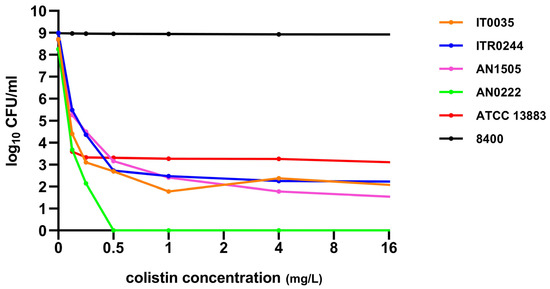
Figure 1.
Population analysis profiles of the three CH strains (IT0035, ITR0244, AN1505), CS (AN0222), a CH reference strain (ATCC 13883), and a CR (8400).

Table 2.
MIC of resistant subpopulation of CH strains against colistin (COL) and colistin-associated genetic modifications identified in them.
3.2. Time–Kill Curve Assays
In the time–kill assay curves, colistin initially displayed a rapid bactericidal effect against all the strains, as evidenced by the (≥7 log10 to ≤3 log10 CFU/mL) decrease within 1 h of exposure (Figure 2). However, after 2–4 h of exposure to colistin, there was an increase in the number of colonies (≥7 log10) in all the CH strains except the CS strain AN0222 (Figure 2). This indicated that colistin was ineffective at completely eradicating these three CH strains due to the selection and enrichment of the resistant subpopulation after initially killing the susceptible population.
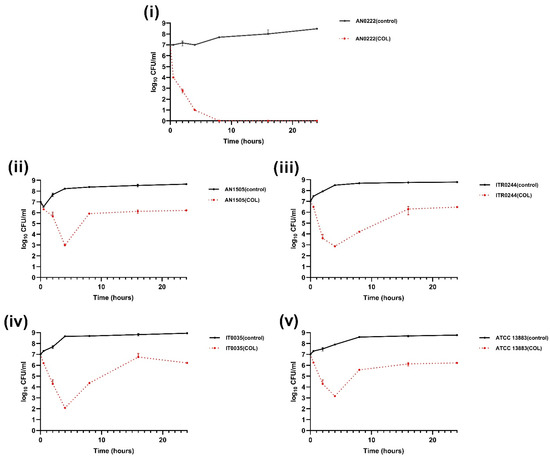
Figure 2.
Time–kill curves of 2 mg/L colistin (COL). CS strain (i) AN0222 displayed sharp decrease in colony counts when exposed to colistin with no regrowth observed over time. CH strains (ii) AN1505, (iii) ITR0244, (iv) IT0035, (v) ATCC 13883 displayed an initial decrease followed by increasing colony counts (colistin resistant subpopulation) after 2–4 h of exposure to colistin.
Next, the effect of colistin in combination with amikacin, gentamicin, meropenem, imipenem, or tigecyline was analysed using time–kill assay curves. In the colistin + gentamicin combination, the resistant subpopulation of CH strains was found to be eliminated for CH K. pneumoniae strains ITR0244 (Figure 3ii) and IT0035 (Figure 3iii), but not for the CH K. pneumoniae strain AN1505 for which regrowth of the colistin-resistant subpopulation occurred despite the presence of gentamicin (Figure 3i). In the colistin + amikacin, colistin + imipenem, colistin + meropenem and colistin + tigecycline combinations, the number of colonies decreased rapidly with time, and after 4 h there was no regrowth of resistant subpopulation colonies in any of the three strains, contrary to experiments in which they were exposed to colistin alone (Figure 4, Figure 5, Figure 6 and Figure 7). In the amikacin + colistin combination, a rapid decrease (≥7 log10 to ≤1 log10) and complete elimination of colonies were seen within 4 h in all the CH strains (Figure 4). However, when amikacin was used alone, the number of colonies decreased gradually with time except for the control CH strain (K. pneumoniae ATCC 13883). Similarly, when meropenem and imipenem was used along with colistin, a rapid decrease (≥7 log10 to ≤1 log10) of colonies can be seen, which was not the case when it was used alone (Figure 5 and Figure 6). Interestingly, CH strain ITR0244 was found to exhibit a heteroresistance growth pattern (Figure 5ii and Figure 6ii) when exposed to meropenem and imipenem alone, indicating a phenomenon of multi-drug heteroresistance. Similarly, CH strain AN1505 was also found to exhibit a heteroresistance growth pattern to meropenem in addition to colistin (Figure 6i). As expected, tigecyline when used alone did not affect the growth of the number of colonies at any point of time in any of the strains since the tigecycline MIC of the strains was greater or equivalent to the tigecyline antibiotic concentration (1 mg/L) used in the time–kill curve assay (Figure 7). However, when tigecycline was combined with colistin, it was found to provide synergistic effects, thus preventing resistant subpopulations in the CH strains.
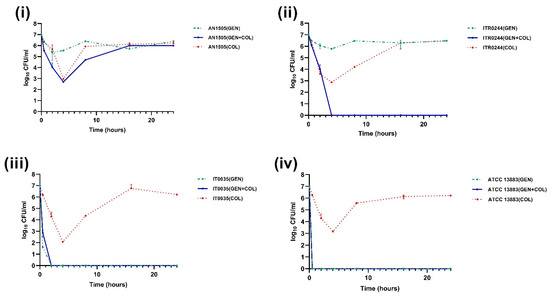
Figure 3.
Time–kill curves of 2 mg/L colistin combined with 16 mg/L gentamicin (GEN). Except CH strain (i) AN1505, the resistant subpopulation was found to be eliminated in case of all other CH strains (ii) ITR0244, (iii) IT0035 and (iv) ATCC 13883 when exposed to colistin + gentamicin combination.
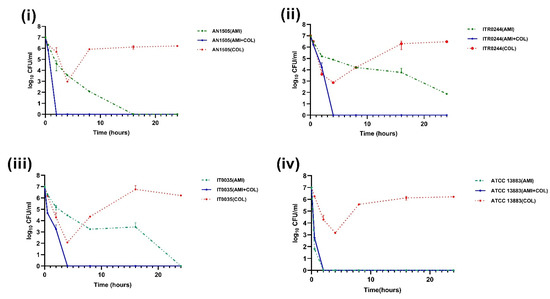
Figure 4.
Time–kill curves of 2 mg/L colistin combined with 64 mg/L amikacin (AMI). The colistin resistant subpopulation was found to be eliminated in all the CH strains (i) AN1505, (ii) ITR0244, (iii) IT0035 and (iv) ATCC 13883 when exposed to colistin + amikacin combination.
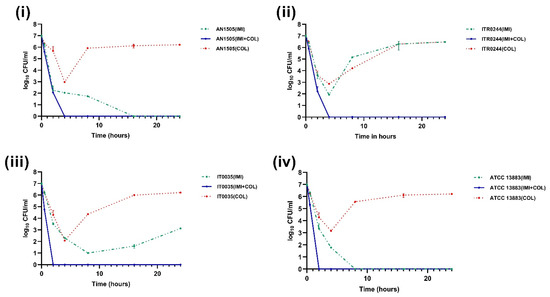
Figure 5.
Time–kill curves of 2 mg/L colistin combined with 26 mg/L imipenem (IMI). The colistin resistant subpopulation was found to be eliminated in all the CH strains (i) AN1505, (ii) ITR0244 (iii) IT0035 and (iv) ATCC 13883 when exposed to colistin + imipenem combination.
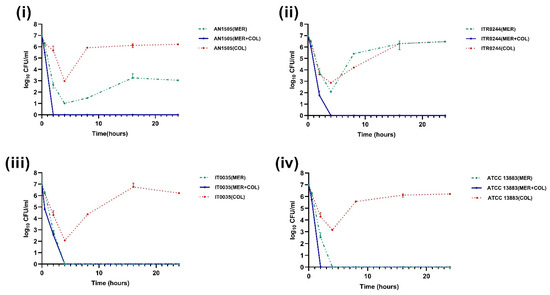
Figure 6.
Time–kill curves of 2 mg/L colistin combined with 23 mg/L meropenem (MER). The colistin resistant subpopulation was found to be eliminated in case of all the CH strains (i) AN1505, (ii) ITR0244 (iii) IT0035 and (iv) ATCC 13883 when exposed to colistin + meropenem combination.
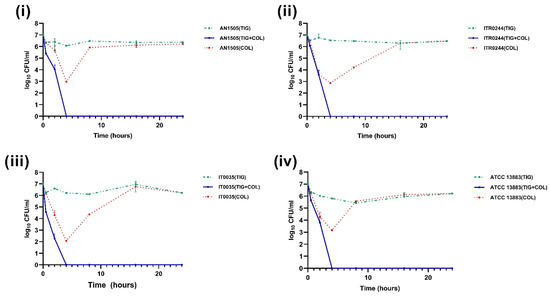
Figure 7.
Time–kill curves of 2 mg/L colistin combined with 1 mg/L tigecycline (TIG). The colistin resistant subpopulation was found to be eliminated in all the CH strains (i) AN1505, (ii) ITR0244 (iii) IT0035 and (iv) ATCC 13883 when exposed to colistin + tigecycline combination.
3.3. Mutations Associated with Colistin Resistance Observed in the Heteroresistant Subpopulations
While all the three parental CH strains (ITR0244, AN1505, IT0035) were found to have an intact mgrB gene, their corresponding resistant subpopulation colonies (ITR0244-R1, ITR0244-R2, AN1505-R1, AN1505-R2, IT0035-R1, IT0035-R2) (ITR0244, IT0035, AN1505) were found to contain IS elements disruptions in the mgrB gene (Table 2). IS903B of IS5 family was identified to be involved in the mgrB interruption of ITR0244-R1, AN1505-R1, AN1505R-2 and IT0035-R1. Also, IS elements ISkpn34 of IS3 family and ISKpn14 of IS1 family was found to be involved in mgrB interruption of ITR0244-R2 and IT0035-R2, respectively.
4. Discussion
In our study, among the three MDR CH K. pneumoniae strains identified by PAP assays, two of them belong to ST15 and ST323, which are known multi-drug-resistant clones. Similarly, there are also other studies, where CH isolates belonging to well-known multi-drug-resistant international lineages such as ST11, ST307 were identified [24,29,30,31,32]. The association of colistin heteroresistance with isolates belonging to MDR clones which are known to be globally disseminated is very worrying since infections due to such strains are more likely to be treated with colistin if these are misclassified as susceptible by clinical diagnostic testing. The mgrB gene, which acts as the negative regulator of two component system PhoPQ was identified to be disrupted by IS elements ISKpn14 and IS903B in these CH-resistant subpopulatons. Hence, disruption of mgrB may result in overexpression of PhoPQ, which in turn is found to result in a subsequent increase in modifications of lipid A which confers colistin resistance [33]. Several studies have reported and validated the role of mgrB gene inactivation by point mutations, deletions or by insertion of IS elements in conferring colistin resistance [13,24,34].
The addition of colistin heteroresistance to the already significant public health threat of multi-drug resistance makes the development of new, combination treatment regimens more imperative. The in vitro time–kill curve assay results in this study demonstrated the potential of the CH strains to regrow significantly after 24 h after exposure to colistin. This could possibly be in line with the difficulty associated with treating infections caused by CH isolates, which may lead to clinical failure. The substantial regrowth after the initial rapid killing of the susceptible population also suggests that heteroresistance could progress to full-blown resistance with the continuous usage of colistin.
Here, we have evaluated the efficacy of colistin combined with different drugs to prevent the growth of resistant subpopulations with time. Using time–kill assay curves we show that the combination of colistin with aminoglycosides (amikacin, gentamicin), carbapenem (meropenem, imipenem) and tigecycline, a glycylcycline drug can effectively eliminate the growth of resistant subpopulations in such CH strains.
The high MIC values of the CH strains AN1505 and ITR0244 to gentamicin (MIC of 48 mg/L and of 24 mg/L, respectively) could be associated with the presence of aac(3)-IIa gene which is known to be associated with gentamicin resistance in K. pneumoniae [13]. Despite this, an in vitro synergistic effect of gentamicin with colistin resulted in the complete elimination of strain ITR0244. The presence of aac(6′)-Ib-cr in CH strains ITR0244, IT0035 and AN1505 resulted in the slow bactericidal activity of amikacin, thus resulting in gradual elimination of the subresistant population. However, the resistant subpopulations were found to be eliminated rapidly when amikacin was used in combination with colistin, indicating in vitro synergistic activity. The presence of a blaOXA-48 carbapenemase gene in the CH ITR0244 strain resulted in the emergence of carbapenem-resistant subpopulations when exposed to meropenem and imipenem alone. Thus, this CH ITR0244 strain proved to be carbapenem heteroresistant too. However, the resistant subpopulation growth of this strain exhibiting multi-drug heteroresistance was found to be prevented by the combination of colistin with any of the two carbapenem drugs. Hence, our study results are found to be in line with the recent reports suggesting the enhanced efficacy of antibiotic combinations to combat strains displaying multi-drug heteroresistance [23].
Similarly, several studies did also attempt to evaluate the potential of various drug associations with colistin in order to suppress colistin heteroresistance. In 2021, a study by Tian and Zhang reported that nearly half of the 95 carbapenem-resistant (CR) K. pneumoniae clinical isolates from a tertiary teaching hospital in China were heteroresistant to both tigeycline and polymyxin B. They also showed that the combination of tigecycline and polymyxin B was effective for preventing the resistant subpopulation in polymyxin B–tigecycline heteroresistant K. pneumoniae strains [21].
Another recent study reported a 72% prevalence of CH strains among 96 clinical CR K. pneumoniae isolates which were isolated from three tertiary hospitals in Beijing, China. Majority of the identified CH strains was found to belong to ST 11 (n = 69; 70.4%) followed by ST37 (n = 13; 12.3%). Additionally, colistin when combined with tetracyclines (minocycline and its glycylcycline derivative, tigecycline) or aminoglycosides (amikacin or gentamicin) was shown to produce in vitro synergistic effects in the identified carbapenem-resistant CH K. pneumoniae strains [22]. Though our study has also shown the prevention of the growth of the resistant subpopulation of CH strains by using different colistin combinations, the antibiotic concentrations used here were made to be in line with the peak serum concentration in patients receiving standard doses.
Recent guidelines from The Infectious Diseases Society of America (IDSA) recommends avoiding or restricting the usage of colistin and polymyxin B for the treatment of carbapenem-resistant Enterobacterales due to increased mortality and excess nephrotoxicity associated with polymyxin-based monotherapy [35]. However, the International Consensus Guidelines for the Optimal Use of the Polymyxins recommends combination therapy of polymyxin along with an additional antibiotic agent, preferentially with the one to which the infecting pathogen is susceptible [28]. Along similar lines, our results suggests that even in infections caused by CS strains, it is safer to prescribe colistin in any of these combinations while treating infections in order to eliminate the enrichment of the resistant subpopulation due to colistin exposure in case of CH strains. As the next steps, detailed in vivo studies are mandatory in order to optimize and implement these colistin combination therapies on a clinical scale.
5. Conclusions
In conclusion, our study highlights the potential benefit of using a combination of colistin with several other drug classes among which are carbapenems, aminoglycosides or tigecycline for the treatment of infections caused by CH K. pneumoniae strains. Pharmacokinetic and pharmacodynamic studies on these colistin combinations will be highly effective in devising strategies to combat CH treatment failures in hospitals. Also, the identified three clonally unrelated CH K. pneumoniae strains whose resistant subpopulations were found to harbor mgrB gene inactivation by IS elements, namely ISKpn14, IS1S and IS903B. This phenomenon might indicate prior exposure of these strains to colistin pressure which might have induced the transposition event causing inactivation of mgrB. The results of the in vitro time–kill curve assays demonstrated the ineffectiveness of colistin alone to achieve complete elimination of CH strains with rapid regrowth of full-resistant populations following exposure; hence, there is a potentially high risk of treatment failure in vivo. Although our study suffers from a limitation that only a small number of CH strains was used, it highlights the need for further studies in order to understand how factors such as the proportion of resistant subpopulations and their degree of resistance can influence treatment outcomes. A more standardized definition and diagnostic techniques will aid in better detection of these strains and subsequently aid clinicians in selecting appropriate therapeutic options. Additional studies on the prevalence and worldwide distribution of CH strains are needed to further understand their epidemiological and clinical relevance.
Author Contributions
Conceptualization and study design: S.M.-K.; PAP and time–kill assay protocols: S.G.R. and B.B.X.; Experimental execution and logistics: S.G.R., B.B.X., A.S., E.B.M. and C.L.; Bioinformatics: B.B.X. and S.G.R.; Manuscript writing: S.M.-K., Y.G. and S.G.R.; Manuscript review and editing: all authors. All authors have read and agreed to the published version of the manuscript.
Funding
S.G.R. and part of this study are funded by University of Antwerp BOF Doctoral Project Funds (BOF-DOCPRO 2019–project ID 40179). S.M.-K. gratefully acknowledges University of Antwerp Methusalem funding (Vaccine & Infectious Diseases Excellence in Antwerp: Infectious disease prevention, control and management in a One Health policy context (VAX-IDEA)).
Institutional Review Board Statement
Not applicable.
Informed Consent Statement
Not applicable.
Data Availability Statement
All sequence data generated and analyzed in this study were deposited at NCBI under BioProject: PRJNA948355.
Acknowledgments
We thank Sabine Chapelle, Gert Leten, and Liesbeth Bryssinck for excellent technical support.
Conflicts of Interest
The authors declare that the research was conducted in the absence of any commercial or financial relationships that could be construed as potential conflict of interest.
References
- Effah, C.Y.; Sun, T.; Liu, S.; Wu, Y. Klebsiella pneumoniae: An increasing threat to public health. Ann. Clin. Microbiol. Antimicrob. 2020, 19, 1. [Google Scholar] [CrossRef]
- Ustundag, G.; Oncel, E.K.; Sahin, A.; Keles, Y.E.; Aksay, A.K.; Ciftdogan, D.Y. Colistin Treatment for Multidrug-Resistant Gram-Negative Infections in Children: Caution Required for Nephrotoxicity. Sisli. Etfal Hastan Tip. Bul. 2022, 56, 427–434. [Google Scholar] [CrossRef] [PubMed]
- Magiorakos, A.-P.; Srinivasan, A.; Carey, R.B.; Carmeli, Y.; Falagas, M.E.; Giske, C.G.; Harbarth, S.; Hindler, J.F.; Kahlmeter, G.; Olsson-Liljequist, B.; et al. Multidrug-resistant, extensively drug-resistant and pandrug-resistant bacteria: An international expert proposal for interim standard definitions for acquired resistance. Clin. Microbiol. Infect. 2012, 18, 268–281. [Google Scholar] [CrossRef]
- Berglund, B. Acquired Resistance to Colistin via Chromosomal And Plasmid-Mediated Mechanisms in Klebsiella pneumoniae. Infect. Microbes Dis. 2019, 1, 10–19. [Google Scholar] [CrossRef]
- El-Sayed Ahmed, M.A.E.G.; Zhong, L.-L.; Shen, C.; Yang, Y.; Doi, Y.; Tian, G.-B. Colistin and its role in the Era of antibiotic resistance: An extended review (2000–2019). Emerg. Microbes Infect. 2020, 9, 868–885. [Google Scholar] [CrossRef] [PubMed]
- Poirel, L.; Jayol, A.; Nordmann, P. Polymyxins: Antibacterial Activity, Susceptibility Testing, and Resistance Mechanisms Encoded by Plasmids or Chromosomes. Clin. Microbiol. Rev. 2017, 30, 557–596. [Google Scholar] [CrossRef]
- Band, V.I.; Weiss, D.S. Heteroresistance: A cause of unexplained antibiotic treatment failure? PLoS Pathog. 2019, 15, e1007726. [Google Scholar] [CrossRef]
- Jeannot, K.; Bolard, A.; Plésiat, P. Resistance to polymyxins in Gram-negative organisms. Int. J. Antimicrob. Agents 2017, 49, 526–535. [Google Scholar] [CrossRef]
- Umair, M.; Hassan, B.; Farzana, R.; Ali, Q.; Sands, K.; Mathias, J.; Afegbua, S.; Haque, M.N.; Walsh, T.R.; Mohsin, M. International manufacturing and trade in colistin, its implications in colistin resistance and One Health global policies: A microbiological, economic, and anthropological study. Lancet Microbe 2023, 4, e264–e276. [Google Scholar] [CrossRef]
- Aghapour, Z.; Gholizadeh, P.; Ganbarov, K.; Bialvaei, A.Z.; Mahmood, S.S.; Tanomand, A.; Yousefi, M.; Asgharzadeh, M.; Yousefi, B.; Kafil, H.S. Molecular mechanisms related to colistin resistance in Enterobacteriaceae. Infect. Drug Resist. 2019, 12, 965–975. [Google Scholar] [CrossRef]
- Lepe, J.; Martínez-Martínez, L. Resistance mechanisms in Gram-negative bacteria. Med. Intensiv. 2022, 46, 392–402. [Google Scholar] [CrossRef]
- Fordham, S.M.E.; Mantzouratou, A.; Sheridan, E. Prevalence of insertion sequence elements in plasmids relating to mgrB gene disruption causing colistin resistance in Klebsiella pneumoniae. Microbiologyopen 2022, 11, e1262. [Google Scholar] [CrossRef]
- Cannatelli, A.; Giani, T.; D’Andrea, M.M.; Di Pilato, V.; Arena, F.; Conte, V.; Tryfinopoulou, K.; Vatopoulos, A.; Rossolini, G.M. MgrB Inactivation Is a Common Mechanism of Colistin Resistance in KPC-Producing Klebsiella pneumoniae of Clinical Origin. Antimicrob. Agents Chemother. 2014, 58, 5696–5703. [Google Scholar] [CrossRef]
- Andersson, D.I.; Nicoloff, H.; Hjort, K. Mechanisms and clinical relevance of bacterial heteroresistance. Nat. Rev. Genet. 2019, 17, 479–496. [Google Scholar] [CrossRef] [PubMed]
- Ezadi, F.; Ardebili, A.; Mirnejad, R. Antimicrobial Susceptibility Testing for Polymyxins: Challenges, Issues, and Recommendations. J. Clin. Microbiol. 2019, 57, e01390-18. [Google Scholar] [CrossRef]
- Meletis, G.; Tzampaz, E.; Sianou, E.; Tzavaras, I.; Sofianou, D. Colistin heteroresistance in carbapenemase-producing Klebsiella pneumoniae. J. Antimicrob. Chemother. 2011, 66, 946–947. [Google Scholar] [CrossRef] [PubMed]
- Roch, M.; Sierra, R.; Andrey, D.O. Antibiotic heteroresistance in ESKAPE pathogens, from bench to bedside. Clin. Microbiol. Infect. 2022, 29, 320–325. [Google Scholar] [CrossRef] [PubMed]
- El-Halfawy, O.M.; Valvano, M.A. Antimicrobial Heteroresistance: An Emerging Field in Need of Clarity. Clin. Microbiol. Rev. 2015, 28, 191–207. [Google Scholar] [CrossRef] [PubMed]
- Landman, D.; Salamera, J.; Quale, J. Irreproducible and Uninterpretable Polymyxin B MICs for Enterobacter cloacae and Enterobacter aerogenes. J. Clin. Microbiol. 2013, 51, 4106–4111. [Google Scholar] [CrossRef]
- Ni, W.; Yang, D.; Guan, J.; Xi, W.; Zhou, D.; Zhao, L.; Cui, J.; Xu, Y.; Gao, Z.; Liu, Y. In vitro and in vivo synergistic effects of tigecycline combined with aminoglycosides on carbapenem-resistant Klebsiella pneumoniae. J. Antimicrob. Chemother. 2021, 76, 2097–2105. [Google Scholar] [CrossRef]
- Tian, Y.; Zhang, Q.; Wen, L.; Chen, J. Combined effect of Polymyxin B and Tigecycline to overcome Heteroresistance in Carbapenem-Resistant Klebsiella pneumoniae. Microbiol. Spectr. 2021, 9, e0015221. [Google Scholar] [CrossRef] [PubMed]
- Wang, Y.; Ma, X.; Zhao, L.; He, Y.; Yu, W.; Fu, S.; Ni, W.; Gao, Z. Heteroresistance Is Associated With in vitro Regrowth During Colistin Treatment in Carbapenem-Resistant Klebsiella pneumoniae. Front. Microbiol. 2022, 13, 868991. [Google Scholar] [CrossRef] [PubMed]
- Band, V.I.; Hufnagel, D.A.; Jaggavarapu, S.; Sherman, E.X.; Wozniak, J.E.; Satola, S.W.; Farley, M.M.; Jacob, J.T.; Burd, E.M.; Weiss, D.S. Antibiotic combinations that exploit heteroresistance to multiple drugs effectively control infection. Nat. Microbiol. 2019, 4, 1627–1635. [Google Scholar] [CrossRef] [PubMed]
- Halaby, T.; Kucukkose, E.; Janssen, A.B.; Rogers, M.R.C.; Doorduijn, D.J.; van der Zanden, A.G.M.; al Naiemi, N.; Vandenbroucke-Grauls, C.M.J.E.; van Schaik, W. Genomic Characterization of Colistin Heteroresistance in Klebsiella pneumoniae during a Nosocomial Outbreak. Antimicrob. Agents Chemother. 2016, 60, 6837–6843. [Google Scholar] [CrossRef]
- Poudyal, A.; Howden, B.P.; Bell, J.M.; Gao, W.; Owen, R.J.; Turnidge, J.D.; Nation, R.L.; Li, J. In vitro pharmacodynamics of colistin against multidrug-resistant Klebsiella pneumoniae. J. Antimicrob. Chemother. 2008, 62, 1311–1318. [Google Scholar] [CrossRef]
- Benítez-Cano, A.; Luque, S.; Sorlí, L.; Carazo, J.; Ramos, I.; Campillo, N.; Curull, V.; Sánchez-Font, A.; Vilaplana, C.; Horcajada, J.P.; et al. Intrapulmonary concentrations of meropenem administered by continuous infusion in critically ill patients with nosocomial pneumonia: A randomized pharmacokinetic trial. Crit. Care 2020, 24, 55. [Google Scholar] [CrossRef]
- Erttmann, M.; Krausse, R.; Ullmann, U. Pharmacokinetics of imipenem in patients undergoing major colon surgery. Infection 1990, 18, 367–371. [Google Scholar] [CrossRef]
- Tsuji, B.T.; Pogue, J.M.; Zavascki, A.P.; Paul, M.; Daikos, G.L.; Forrest, A.; Giacobbe, D.R.; Viscoli, C.; Giamarellou, H.; Karaiskos, I.; et al. International Consensus Guidelines for the Optimal Use of the Polymyxins: Endorsed by the American College of Clinical Pharmacy (ACCP), European Society of Clinical Microbiology and Infectious Diseases (ESCMID), Infectious Diseases Society of America (IDSA), International Society for Anti-infective Pharmacology (ISAP), Society of Critical Care Medicine (SCCM), and Society of Infectious Diseases Pharmacists (SIDP). Pharmacotherapy 2019, 39, 10–39. [Google Scholar] [CrossRef]
- Cheong, H.S.; Kim, S.Y.; Wi, Y.M.; Peck, K.R.; Ko, K.S. Colistin Heteroresistance in Klebsiella Pneumoniae Isolates and Diverse Mutations of PmrAB and PhoPQ in Resistant Subpopulations. J. Clin. Med. 2019, 8, 1444. [Google Scholar] [CrossRef]
- Seo, J.; Wi, Y.M.; Kim, J.M.; Kim, Y.-J.; Ko, K.S. Detection of colistin-resistant populations prior to antibiotic exposure in KPC-2-producing Klebsiella pneumoniae clinical isolates. J. Microbiol. 2021, 59, 590–597. [Google Scholar] [CrossRef]
- Morales-León, F.; Lima, C.A.; González-Rocha, G.; Opazo-Capurro, A.; Bello-Toledo, H. Colistin Heteroresistance among Extended Spectrum β-lactamases-Producing Klebsiella pneumoniae. Microorganisms 2020, 8, 1279. [Google Scholar] [CrossRef] [PubMed]
- Bardet, L.; Baron, S.; Leangapichart, T.; Okdah, L.; Diene, S.M.; Rolain, J.-M. Deciphering Heteroresistance to Colistin in a Klebsiella pneumoniae Isolate from Marseille, France. Antimicrob. Agents Chemother. 2017, 61, e00356-17. [Google Scholar] [CrossRef] [PubMed]
- Mmatli, M.; Mbelle, N.M.; Maningi, N.E.; Osei Sekyere, J. Emerging Transcriptional and Genomic Mechanisms Mediating Carbapenem and Polymyxin Resistance in Enterobacteriaceae: A Systematic Review of Current Reports. mSystems 2020, 5, 10–1128. [Google Scholar] [CrossRef] [PubMed]
- Poirel, L.; Jayol, A.; Bontron, S.; Villegas, M.-V.; Ozdamar, M.; Türkoglu, S.; Nordmann, P. The mgrB gene as a key target for acquired resistance to colistin in Klebsiella pneumoniae. J. Antimicrob. Chemother. 2015, 70, 75–80. [Google Scholar] [CrossRef]
- Tamma, P.D.; Aitken, S.L.; A Bonomo, R.; Mathers, A.J.; van Duin, D.; Clancy, C.J. Infectious Diseases Society of America 2022 Guidance on the Treatment of Extended-Spectrum β-lactamase Producing Enterobacterales (ESBL-E), Carbapenem-Resistant Enterobacterales (CRE), and Pseudomonas aeruginosa with Difficult-to-Treat Resistance (DTR-P. aeruginosa). Clin. Infect. Dis. 2022, 75, 187–212. [Google Scholar] [CrossRef]
Disclaimer/Publisher’s Note: The statements, opinions and data contained in all publications are solely those of the individual author(s) and contributor(s) and not of MDPI and/or the editor(s). MDPI and/or the editor(s) disclaim responsibility for any injury to people or property resulting from any ideas, methods, instructions or products referred to in the content. |
© 2023 by the authors. Licensee MDPI, Basel, Switzerland. This article is an open access article distributed under the terms and conditions of the Creative Commons Attribution (CC BY) license (https://creativecommons.org/licenses/by/4.0/).